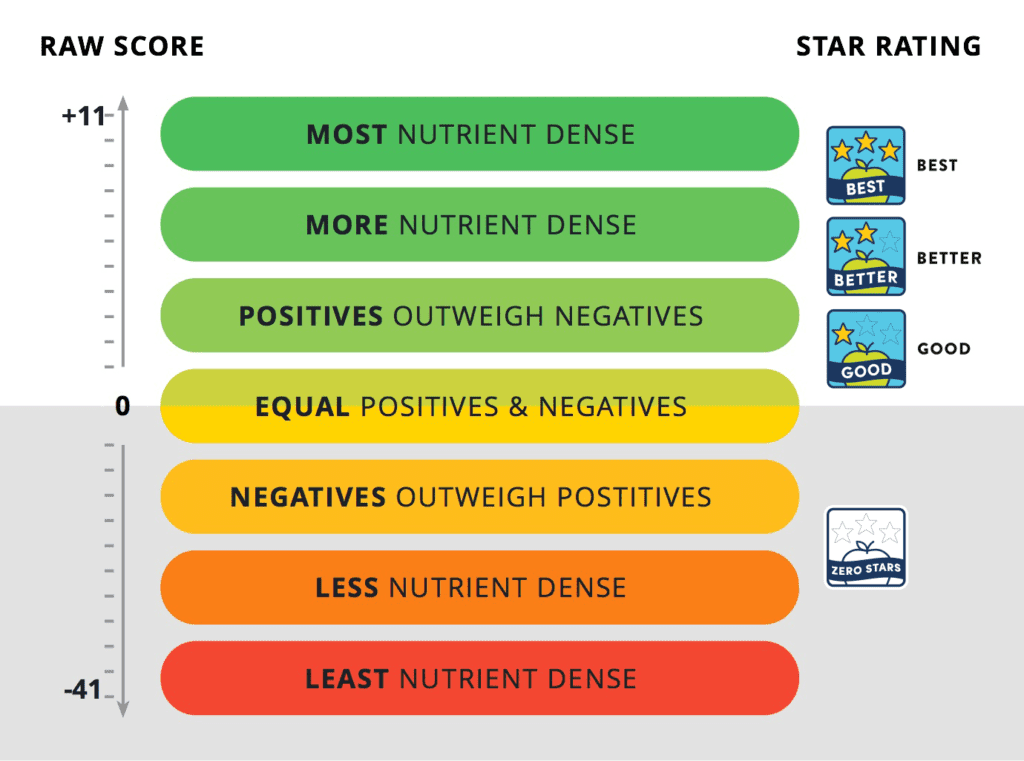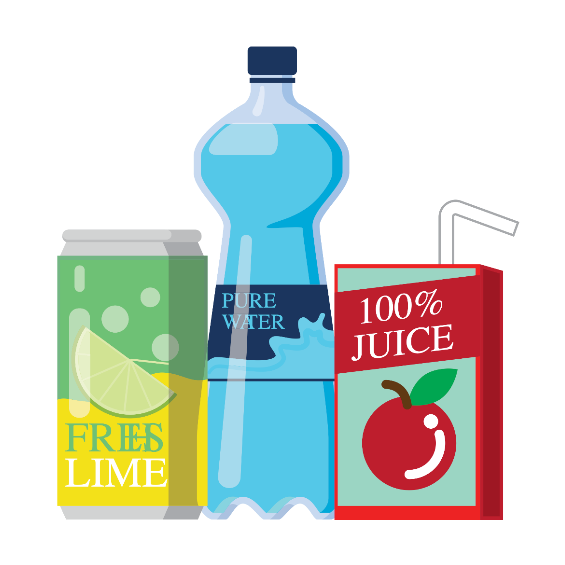The Guiding Stars algorithms are patented, which allows us to be fully transparent about our product evaluations.
What are the Guiding Stars algorithms?
An algorithm is a set of rules that we follow in order to calculate how many Guiding Stars a product earns. We use five separate algorithms to evaluate different categories of products: General Foods; Meats, Poultry, Seafood, Dairy & Nuts; Fats & Oils; Infant & Toddler Foods; and Beverages. These categories are evaluated with unique set of relevant criteria to evaluate and assign Star ratings. This accounts for inherent differences in their nutritional composition and the role that those foods and beverages play in our diets.
Our algorithms are designed to rigorously evaluate the nutrient density of foods or beverages within a category. They were created by a Scientific Advisory Panel which includes experts in nutrition, medicine, biochemistry, and public health. Our Scientific Advisors review the latest nutrition science and when new findings are supported by consensus, as reflected in new policy and guidelines, our algorithms are updated. We occasionally expand our algorithms to enhance the specificity of our guidance for unique populations (like Infants & Toddlers) or product categories (like Beverages).
Data Standardization
Serving sizes on packaged and prepared foods or beverages vary significantly.
In order to determine nutrient density between different kinds of foods, we look at a 100-calorie serving of the food. This allows us to fairly compare across foods in all food categories. We then evaluate the nutrients in that portion of the food.
Products evaluated using the Beverages algorithm are first standardized to a 12-ounce serving size, which is the FDA’s Reference Amount Customarily Consumed (RACC) for most beverages including water, sodas, teas, and coffees.
Dietary Components We Consider
We assign positive or negative points to foods. Dietary components to encourage receive positive points, and components to limit or avoid receive negative points.
- More
- Vitamins
- Minerals
- Fiber
- Whole Grains
- Omega-3s
- Less
- Saturated Fat
- Trans Fat
- Added Sodium
- Added Sugars
- Additives to Limit
Dietary Components We Don’t Consider
There are many reasons why some nutrients or ingredients are not included in our algorithms. It may be because the nutrient is not associated with a significant health benefit or adverse effect or that it is not included on the product label. As new research emerges and product labels are updated to reflect current scientific consensus and nutritional policy, the Guiding Stars algorithms will likewise be updated to reflect the current dietary recommendations.
How a Food Earns Stars
We total the positive and negative points for nutrients to understand the overall nutrition a food provides. If a food has a positive score, or more of the nutrients to encourage, then it earns 1, 2, or 3 Guiding Stars. Foods that have a negative score don’t earn Guiding Stars. That doesn’t mean they are bad, but that they should be consumed in moderation and paired with star earning foods to balance your meal or snack.

Keywords
We search for keywords in the list of ingredients on product packaging to inform our evaluation. Keywords are used to identify whole grains, live active cultures, sugar alcohols, and additives to limit. We look for keywords in the ingredient list that indicate added sugars or sodium to avoid penalizing products that contain naturally-occurring sugars or sodium (e.g., milk and spinach, respectively).
What We Evaluate
We evaluate foods and beverages at no cost to the manufacturer. This includes national, regional, and store-brand products. This ensures that you can easily compare the stars of all products, that cost is not a barrier, and that our clients’ products are not highlighted over an equally nutritious national brand product. We use the same objective criteria to evaluate all of these foods and beverages. It should go without saying, but manufacturers can’t buy a star.
Our Algorithms
Due to intrinsic differences in the composition of foods and beverages, our Scientific Advisory Panel developed several algorithms to evaluate certain categories with more specific and fine-tuned criteria. With the exception of the Infant & Toddler Foods algorithm, all algorithms are based on a 2,000 calorie per day diet and the U.S. Dietary Guidelines for adults and children over the age of 2.
For specific details on how we calculate points for each algorithm, request our white paper (PDF).
General Foods
Our primary algorithm works well for most foods. This algorithm is used to evaluate fruits, vegetables, cereals & grains, legumes, snack foods, and mixed foods such as a burrito or pasta dish that contains foods from a variety of food groups.
General Foods Algorithm
- More
- Vitamins
- Minerals
- Fiber
- Whole Grains
- Omega-3s
- Less
- Saturated Fat
- Trans Fat
- Added Sodium
- Added Sugars
- Additives to Limit
Meats, Poultry, Seafood, Dairy & Nuts
These foods are naturally higher in certain kinds of fats and generally do not contain dietary fiber, with the exception of nuts. The FDA has different guidelines for meat and seafood regarding saturated fats, and the Dietary Guidelines classify nuts with meats.
Meats, Poultry, Seafood, Dairy & Nuts Algorithm
- More
- Vitamins
- Minerals
- Fiber
- Omega-3s
- Less
- Saturated Fat
- Trans Fat
- Added Sodium
- Added Sugars
- Additives to Limit
Fats & Oils
A separate fats and oils model was created because the other algorithms did not originally include nutrients such as omega-3 fatty acids (which include alpha-linolenic acid, eicosapentaenoic acid [EPA] and docosahexaenoic acid [DHA]) and monounsaturated fatty acids (MUFA) that must be considered to differentiate fats and oils in a meaningful way. Beyond the typical fats and oils such as butter or vegetable oil, we also use this algorithm to evaluate oil-based products such as salad dressings and mayonnaise.
Fats & Oils Algorithm
- More
- Monounsaturated Fatty Acids
- Omega-3s
- Less
- Saturated Fat
- Trans Fat
- Added Sodium
- Added Sugars
- Additives to Limit
Infant & Toddler Foods
A separate algorithm was created to evaluate infant and toddler foods to reflect the unique nutritional needs of this age group. This algorithm is consistent with the others in that it uses a 100-calorie standardization, but it references a 1000-calorie diet as its base as per the Dietary Guidelines for Americans’ recommendations for children under the age of 2.
Infant & Toddler Foods (< 2 years) Algorithm
- More
- Vitamins
- Minerals
- Fiber
- Less
- Added Sodium
- Added Sugars
- Additives to Limit
Beverages
Our beverage algorithm applies to most ready-to-consume drinks which provide hydration. It doesn’t apply to liquids which are intended to replace a meal. A three star beverage won’t receive a single debit. Unlike the other algorithms, beverages are evaluated on a volume-based serving size (e.g. 12 ounces) instead of evaluating on a standard amount of energy (e.g. 100 calories).

Beverages Algorithm
- More
- Fiber
- Vitamins
- Minerals
- Live Active Cultures
- Less
- Added Sugars
- Natural Sugars
- Saturated Fat
- Added Sodium
- Additives to Limit
Foods Ineligible for Guiding Stars
As mentioned above, we evaluate most edible foods and beverages in the store. We only display a rating if an item earns 1, 2, or 3 stars so as not to shame products that don’t earn a star. If you don’t see the Guiding Star icon, it means the item doesn’t earn a star. There are, however, four exceptions to this rule:
- Foods that have five calories or less per serving (such as spices) are not evaluated by the Guiding Stars program.
- Medical foods, meal replacements, and supplements are not evaluated because we recognize that decisions about including these products in your diet should be made with the help of your doctor.
- Infant formula is not evaluated by the Guiding Stars program. The composition of infant formula is highly regulated and thus is more of a medical food for this reason. We also feel strongly that the decision about the use of formula or breastfeeding is a personal one that should be made by individuals with the help of their child’s pediatrician.
- Alcoholic beverages are not evaluated by the Guiding Stars program.
Algorithm Updates
- Mar. 18, 2024 – Guiding Stars Updates Guidance for Non-Nutritive Sweeteners
- Feb. 15, 2023 – Algorithm Update to Align with Dietary Guidelines for Infants and Toddlers and to Help Consumers Choose Options with Less Added Sugar
- Mar. 8, 2022 – Guiding Stars Nutrition Guidance Program Launches Enhancement to Help Shoppers Make Better Beverage Choices
- Feb. 7, 2019 – The algorithm now treats juice concentrate as an added sugar
- Feb. 1, 2018 – The algorithm now gives a credit for omega-3 fatty acids and DHA & EPA and a debit for artificial colors